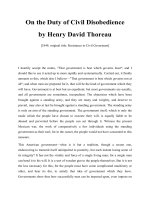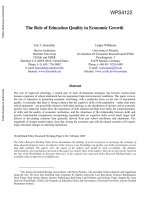Expanding the Reach of Education Reforms potx
Bạn đang xem bản rút gọn của tài liệu. Xem và tải ngay bản đầy đủ của tài liệu tại đây (1.95 MB, 747 trang )
This PDF document was made available
from
www.rand.org as a public service of
the RAND Corporation.
6
Jump down to document
Visit RAND at www.rand.org
Explore RAND Education
View document details
This document and trademark(s) contained herein are protected by law
as indicated in a notice appearing later in this work. This electronic
representation of RAND intellectual property is provided for non-
commercial use only. Permission is required from RAND to reproduce, or
reuse in another form, any of our research documents.
Limited Electronic Distribution Rights
For More Information
CHILD POLICY
CIVIL JUSTICE
EDUCATIO
N
ENERGY AND ENVIRONMENT
HEALTH AND HEALTH CAR
E
INTERNATIONAL AFFAIR
S
NATIONAL SECURIT
Y
POPULATION AND AGIN
G
PUBLIC SAFETY
SCIENCE AND TECHNOLOGY
SUBSTANCE ABUSE
TERRORISM AND
HOMELAND SECURITY
TRANSPORTATION AND
INFRASTRUCTURE
The RAND Corporation is a nonprofit
research organization providing
objective analysis and effective
solutions that address the challenges
facing the public and private sectors
around the world.
Purchase this document
Browse Books & Publications
Make a charitable contribution
Support RAND
This product is part of the RAND Corporation monograph series.
RAND monographs present major research findings that address the
challenges facing the public and private sectors. All RAND mono
-
graphs undergo rigorous peer review to ensure high standards for
research quality and objectivity.
Expanding the Reach
of Education Reforms
Perspectives from Leaders in the Scale-Up
of Educational Interventions
Thomas K. Glennan, Jr., Susan J. Bodilly,
Jolene R. Galegher, Kerri A. Kerr
Prepared for the Ford Foundation
The RAND Corporation is a nonprofit research organization providing
objective analysis and effective solutions that address the challenges
facing the public and private sectors around the world. RAND’s
publications do not necessarily reflect the opinions of its research clients
and sponsors.
R
®
is a registered trademark.
© Copyright 2004 RAND Corporation
All rights reserved. No part of this book may be reproduced in any
form by any electronic or mechanical means (including photocopying,
recording, or information storage and retrieval) without permission in
writing from RAND.
Published 2004 by the RAND Corporation
1700 Main Street, P.O. Box 2138, Santa Monica, CA 90407-2138
1200 South Hayes Street, Arlington, VA 22202-5050
201 North Craig Street, Suite 202, Pittsburgh, PA 15213-1516
RAND URL: />To order RAND documents or to obtain additional information, contact
Distribution Services: Telephone: (310) 451-7002;
Fax: (310) 451-6915; Email:
Library of Congress Cataloging-in-Publication Data
Expanding the reach of education reforms : perspectives from leaders in the scale-up of
educational interventions / [edited by] Thomas K. Glennan [et al.].
p. cm.
“MG-248.”
Includes bibliographical references.
ISBN 0-8330-3659-9 (pbk.)
1. School improvement programs—United States. 2. Educational change—United
States. 3. Education—Standards—United States. I. Glennan, Thomas Keith, 1935–
II. Rand Corporation.
LB2822.82.E94 2004
371.2'00973—dc22
2004016652
The research described in this report was conducted by RAND
Education for the Ford Foundation.
iii
Preface
The sporadic and often temporary ability to bring innovations in
education to scale has long frustrated those interested in improving
the performance of K–12 students in America’s public schools. In the
last two decades, however, developers of educational interventions
designed to improve teaching and learning have made some progress
toward this goal, with several demonstrating measurable gains in stu-
dent performance in multiple schools or districts. The purpose of this
book is to capture some of the knowledge of these developers, all of
whom are leaders in the effort to improve the performance of stu-
dents in public schools by introducing innovations in curriculum,
teaching methods, administrative practices, and funding mechanisms.
This volume grew out of a series of meetings of developers of
K–12 reforms convened by RAND Education, a division of the
RAND Corporation. The meetings, sponsored by the Ford Foun-
dation, were intended to explore the experiences of the designers of
reform efforts, with a particular focus on identifying common
problems in scaling up reforms and, if possible, common solutions to
them. Developers of 15 different reform efforts contributed chapters.
The authors attempt to capture their experiences and the lessons they
learned from their efforts to scale up the interventions they had
designed and implemented.
Thomas Glennan and Susan Bodilly convened the meetings that
stimulated these chapters. Along with Jolene Galegher and Kerri
Kerr, they helped to shape the final version of the chapters and wrote
the introduction and summary.
iv Expanding the Reach of Education Reforms
The contributed chapters were the responsibility of the authors,
all of whom are well-known experts in education reform. Their con-
tributions have been reviewed and refined by the editors of this vol-
ume, as well as members of the staff in the Publications Department
of the RAND Corporation, but the views of education reform pre-
sented within each chapter, as well as the data describing the efficacy
of the programs they have designed and implemented, are the sole
responsibility of the contributing authors.
This book should be of interest to funders of education and
education reform efforts, developers of interventions intended to
enhance the performance of students at all levels of schooling, legisla-
tors, state and federal policymakers, educational researchers, and
school authorities interested in supporting efforts to improve teaching
and learning in K–12 education.
v
Dedication
In memory of Tom Glennan, who contributed immeasurably to the
development of this book and the field of study it represents. Tom
was a wonderful scholar, teacher, and friend, and we are grateful to
have had the opportunity to know him and to learn from him.
vii
Contents
Preface iii
Dedication
vii
Figures
xv
Tables
xvii
Acknowledgments
xix
Abbreviations
xxi
CHAPTER ONE
Introduction: Framing the Problem
Susan J. Bodilly, Thomas K. Glennan, Jr., Kerri A. Kerr,
and Jolene R. Galegher
1
Origins and Purpose of This Book
3
Scale-Up in an Earlier Era of Educational Reforms
5
Environmental Shifts in the 1980s and 1990s
13
Lessons from the Field
15
A Conceptual Framework for Scale-Up
27
Outline of the Remainder of the Book
32
References
34
CHAPTER TWO
Cognitively Guided Instruction: Challenging the Core of
Educational Practice
Thomas P. Carpenter and Megan L. Franke
41
The Conceptual Basis for Scaling Up
43
Cognitively Guided Instruction
44
viii Expanding the Reach of Education Reforms
The Development of Children’s Mathematical Thinking 46
CGI in the Classroom
50
The Nature of the Professional Development
51
How Change Occurs
51
Teacher and Student Outcomes
53
Challenges
54
Scaling Up
54
Conclusions
71
Making It Work
76
References
77
CHAPTER THREE
The National Writing Project: Scaling Up and Scaling Down
Joseph P. McDonald, Judy Buchanan, and Richard Sterling
81
The NWP Design
84
A Culture of Risk-Taking
94
Practices of Scaling Down
100
Conclusions
104
References
105
CHAPTER FOUR
Impediments to Scaling Up Effective Comprehensive School
Reform Models
Siegfried E. Engelmann and Kurt E. Engelmann
107
Assumptions About the Context and Nature of Scaling Up
Comprehensive School Reform Models
109
Problems in Scaling Up as a Function of the Demands of the Model
111
Effective Models
116
Patterns of Scaling Up and Their Relative Efficiency
120
Special Challenges of Large School Districts
122
Conclusions
130
References
132
CHAPTER FIVE
Scaling Up Success For All: Lessons for Policy and Practice
Robert E. Slavin and Nancy A. Madden
135
Contents ix
Success For All 137
Program Characteristics Affecting Dissemination
139
Obey-Porter Comprehensive School Reform Demonstration
145
Extending Our Reach
147
Organization and Capital
154
District-Level Failures
157
District-Level Implementations
159
Reconciling District Successes and Failures
161
Lessons Learned
162
Policy Implications
164
Recommendations
165
Conclusions
169
References
171
CHAPTER SIX
Taking Education Programs to Scale: Lessons from the Field
James L. Ketelsen
175
A Brief History of Project GRAD
176
Project GRAD Program Design Elements
179
How Project GRAD Achieves Results
182
The Effects of Project GRAD to Date
186
Challenges in Scaling Up Project GRAD
190
Funding Concepts and Their Effects on Scale-Up
192
Final Observations on Scaling Up Project GRAD
195
Reference
196
CHAPTER SEVEN
Reaching for Coherence in School Reform: The Case of
America’s Choice
Marc Tucker
197
The Need for Coherent Systems to Drive Up Educational
Performance
201
Building Capacity to Operate a Coherent System at Scale:
The Story of the America’s Choice School Design
213
The Tools Needed for Building Capacity
221
Building Capacity at the School, District, and State Levels
241
x Expanding the Reach of Education Reforms
The Case for Third-Party Assistance 253
Putting Coherent Systems in Perspective
254
References
258
CHAPTER EIGHT
A Different Way of Growing
Linda A. Johannesen
259
Development and Implementation of the Different Ways of
Knowing Design Through 1998
261
Responding to New Demands for School Reform Services
After 1998: Building Capacity
279
Challenges Associated with Supporting the Goals of the No Child
Left Behind Act
291
The Future of Schoolwide Reform: Obtaining the Resources
to Support Intermediary Organizations
295
References
297
CHAPTER NINE
Co-nect at the Crossroads: Four Considerations on Getting
to Scale
Bruce Goldberg
303
The Climate and Conditions for Scaling Up
304
Scaling Success: Attention to Results
310
Scaling the Desirable
318
The Feasibility of Scale
323
Sustaining Reform: Co-nect at the Crossroads
333
Conclusions
346
References
347
CHAPTER TEN
Scaling Up Turning Points Through Autonomous Regional
Centers
Dan French and Leah Rugen
351
The Turning Points Design
352
A Brief History of the Turning Points Design
357
Creating the Turning Points Network of Regional Centers
363
Contents xi
Looking Ahead: Building on Strengths, Facing New Challenges 376
References
377
CHAPTER ELEVEN
Scaling Up Talent Development High Schools: Lessons Learned from
Comprehensive High School Reform
Nettie E. Legters, James M. McPartland, and Robert Balfanz
379
What Is Wrong with Comprehensive High Schools, and
Why Are They So Difficult to Change?
380
Challenges to Implementing and Scaling Up TDHS
390
Meeting the Challenges
409
It Is Not Too Late for Reforms in High Schools
425
References
429
CHAPTER TWELVE
Taking High Schools That Work to Scale: The Evolution of a
High School Reform Program
Gene Bottoms
433
Linking Career and Technical Education to High School Reform:
The Impetus for HTSW
435
Phase I: Launching HSTW
437
Phase II: Scaling Up HSTW
454
Phase III: Increasing Breadth, Depth, Stability, and Financial
Resources
462
Achieving Success at Scale: Lessons from the Past and Challenges
for the Future
474
Closing Thoughts
484
References
485
CHAPTER THIRTEEN
The First Few Years of Edison Schools: Ten Lessons in
Getting to Scale
John E. Chubb
487
Lesson One: Start with a Proven Reform Model—and
Standardize It
489
Lesson Two: Hire and Fire Your Own Principals and Teachers
494
xii Expanding the Reach of Education Reforms
Lesson Three: Build Effective and Efficient Support Systems 497
Lesson Four: Build Site Capacity
500
Lesson Five: Establish Clear and Simple Accountability Systems
502
Lesson Six: Establish Strong Measurement Systems
504
Lesson Seven: Get Measurable Results—Fast
506
Lesson Eight: Satisfy Your Customers
509
Lesson Nine: Adjust To Local Norms
511
Lesson Ten: Find a Better Balance of Growth, Systems,
and Profitability
513
References
516
CHAPTER FOURTEEN
School Districts as Learning Organizations: A Strategy for
Scaling Education Reform
Thomas K. Glennan, Jr., and Lauren B. Resnick
517
Providing High-Quality Education for All Students
519
The District as the Target of Reform
522
Building High-Performance School Districts: A Theory of Action
537
Lessons from Experience
549
Closing Thoughts
559
References
560
CHAPTER FIFTEEN
Choices and Consequences in the Bay Area School Reform
Collaborative: Building the Capacity to Scale Up Whole-School
Improvement
Merrill Vargo
565
Scaling Up Capacity for Continuous Improvement
567
Building Capacity in Education Organizations
569
A Focus on Cultural Change
571
Organizational Capacity and Continuous Improvement in Action
572
A Response: BASRC’s History and Approach
577
BASRC Results
579
Early Strategic Choices and BASRC’s View of Scale
580
Building on the Policy Context: Choices and More Choices
584
Lessons Learned About Scale
598
Contents xiii
References 601
CHAPTER SIXTEEN
Leveraging the Market to Scale Up School Improvement Programs:
A Fee-for-Service Primer for Foundations and Nonprofits
Marc Dean Millot
603
My Vantage Point
605
Philanthropy’s Challenge
606
How NAS Came to the Fee-For-Service Strategy
610
Pursuing a Fee-for-Service Dissemination Strategy
617
Are Developers Ready for Scale?
622
The Role of Foundations in Attaining Scalability
635
Conclusions
645
Reference
646
CHAPTER SEVENTEEN
Summary: Toward a More Systematic Approach to Expanding
the Reach of Educational Interventions
Thomas K. Glennan, Jr., Susan J. Bodilly, Jolene R. Galegher,
and Kerri A. Kerr
647
Further Elaboration of the Scale-Up Process
648
Core Tasks in the Scale-Up Process
652
Conclusions
681
References
684
APPENDIX
A. Contributors 687
B. Program Descriptions and Contact Information
701
xv
Figures
1.1. The Replication Model of Scale-Up 11
1.2. The Interactive Process of Scale-Up
28
7.1. Coherence Matrix
256
8.1. KIRIS Index Point Gains over Two Years
276
14.1. IFL Theory of Action
538
16.1. Spending on K–12 School Improvement: Foundation
Grants Versus School Purchases
607
17.1. The Detailed Interactive Model of Scale-Up
649
xvii
Tables
1.1. Interventions Included in This Volume 6
6.1. TAAS Passing Rates, 1994 and 2002
188
6.2. TAAS Passing Rate for Fifth-Graders
189
8.1. Chronology of the Different Ways of Knowing
Kentucky Scale-Up
269
8.2. Chronology of Research, Development, and
National Expansion
281
9.1. Capsule History of Co-nect 1992–2002
307
10.1. Turning Points Core Practices
354
10.2. Current Turning Points Guides
356
10.3. Profile of Current Regional Centers
366
11.1. Challenges Comprehensive Public High Schools Face,
Common Reform Principles Addressing the Challenges,
and Specific Reform Strategies
382
12.1. Requirements for State Participation in HSTW
438
12.2. Key Conditions for Accelerating Student Achievement
440
12.3. Key Practices for Accelerating Student Achievement
441
12.4. Requirements for Becoming an HSTW Site
452
14.1. Core Principles
525
xix
Acknowledgments
The enterprise that led to the book was prompted by a single
important question from Janice Petrovich of the Ford Foundation.
Familiar with our previous work as analysts of education reform
efforts, she asked us how we would explain the frequent failure of
reform efforts to scale up. The Ford Foundation sponsored two
meetings at which national leaders in efforts to scale up school
reforms were invited to present their ideas and experiences as devel-
opers of diverse approaches to education reform. We thank Janice
and the foundation for their interest in and support of this work.
The developers—who eventually became the contributors to this
volume—responded enthusiastically to our invitation. At each of the
two meetings, they provided many worthwhile and insightful contri-
butions, thus helping each other to identify both the common and
the unique aspects of their respective efforts and, thereby, contribut-
ing to a general understanding of the complexities of scaling up edu-
cation reforms. The targets of their efforts—particular areas of the
curriculum, levels of education, networks of teachers, state education
policies—varied widely, but they held in common an intense and
enduring commitment to improving the quality of education for all
of America’s children. We appreciate both their participation in these
meetings and their responsiveness to our recommendations as they
developed and refined the papers presented here.
Our colleagues Jake Dembosky and Gina Ikemoto supported
the meetings by taking notes and conveying the notes quickly and
efficiently back to the contributors. Steve Bloodsworth designed the
xx Expanding the Reach of Education Reforms
cover; Daniel Sheehan provided preliminary editorial advice, and
Phyllis M. Gilmore edited the final version; Carolyn Rowe helped
organize production; and John Warren helped organize prepublica-
tion marketing. Peter Hoffman, Managing Editor of RAND Publica-
tions, answered many important questions about the publication
process and, along with other members of the Publications staff,
helped us push this book out the door.
The editors thank all these individuals for their help in this
effort.
xxi
Abbreviations
AED Academy for Educational Development
ARPANET Advanced Research Projects Agency Network
(precursor to the Internet)
AYP Adequate Yearly Progress
BASRC the Bay Area School Reform Collaborative
BAWP Bay Area Writing Project
BBN BBN Technologies, a technology oriented R&D
company
CCE Center for Collaborative Education
CCIU Chester County Intermediate Unit
CES Coalition of Essential Schools
CFO chief financial officer
CGI cognitively guided instruction
CIS Communities in Schools
CMO chief marketing officer
CMCD Consistency Management and Cooperative
Discipline
COI cycle of inquiry
CPRD Center for Prevention Research and Development
CPRE Consortium for Policy Research in Education
CSRD Comprehensive School Reform Demonstration
Program
DI Direct Instruction
xxii Expanding the Reach of Education Reforms
HISD Houston Independent School District
HSTW High Schools That Work
IFL Institute for Learning
KERA Kentucky Education Reform Act
KET Kentucky Educational Television
KIRIS Kentucky Instructional Results Information System
LRDC Learning Research and Development Center
(University of Pittsburgh)
MBA master of business administration
MMGW Making Middle Grades Work
MTF mathematical team facilitators
NAS New American Schools
NCEE National Center on Education and the Economy
NCLB No Child Left Behind Act
NIFDI National Institute for Direct Instruction
NWP National Writing Project
OERI Office of Educational Research and Improvement
(U.S. Department of Education)
PCA Pittsburgh Center for the Arts
PBEC The Public Education and Business Coalition
PG Project GRAD
R&D research and development
SAT Scholastic Aptitude Test
TAAS Texas Assessment of Academic Skills
TDHS Talent Development High School
TIMSS Third International Math and Science Study
1
CHAPTER ONE
Introduction: Framing the Problem
Susan J. Bodilly, Thomas K. Glennan, Jr.,
Kerri A. Kerr, and Jolene R. Galegher
Fifty years ago, Brown v. Board of Education set in motion a series of
legislative and judicial efforts to undo the effects of racial segregation,
providing opportunities and support for children who had been
denied both. Twenty years ago, the publication of A Nation at Risk
(National Commission on Excellence in Education, 1983) drew
attention to the need for reform in all of America’s schools to ensure
the nation’s ability to compete in the international economy. These
two forces—pressure to improve the quality of schools for all students
and pressure to reduce gaps in access and performance of students—
have resulted in both a demand for better approaches to teaching and
learning and a supply of interventions intended to build the capacity
within our schools to serve all children better.
On the demand side, the nation has given education a high
priority, even in the face of economic downturns and international
turmoil. Individual states, some on their own and some under
pressure from federal leaders, have revamped their standards, their
assessment systems, and the incentives they provide to schools to
improve their performance. The federal government, through the No
Child Left Behind Act of 2001, continues to press for improvements
in educational performance within all the many social and ethnic
groups in American society and is holding schools accountable for
achieving it.
On the supply side, private philanthropists and the federal gov-
ernment have invested heavily in developing and disseminating inno-
vative reforms intended to change the existing practices of teachers
and schools. With the help of these investments, organizations exter-









